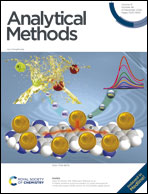Preparation of a boronate-affinity monolithic column for adsorption of nucleosides
Abstract
Chitosan is a considerably versatile and promising biomaterial and can easily form a 3D hierarchical porous scaffold. In this work, a novel boronate-affinity monolithic column modified with a boronic acid–chitosan complex was prepared and characterized by different methods such as Fourier transform infrared spectroscopy, scanning electron microscopy, thermal gravimetric analysis, specific surface area analysis and pore size distribution analysis. The synthesized monolithic column was used for polymer monolithic microextraction combined with high performance liquid chromatography for the simultaneous determination of cytidine, uridine, inosine, and guanosine in milk powder samples. Several parameters affecting extraction efficiency, including the eluent proportion, eluent flow rate, sample flow rate, sample volume, and sample pH were investigated. The boronate-affinity monolithic column showed high enrichment ability due to the selective formation of cyclic borate esters between nucleosides and boronic acid groups at high pH and the release of cyclic borates at low pH values. Under the optimum operating conditions, the linear range was 0.1–50 μg mL−1, and the correlation coefficients were in the range of 0.9993–0.9994. The LOD and LOQ were in the range of 0.0027–0.0034 and 0.0090–0.011 μg mL−1, respectively. In addition, the results of recovery and relative standard deviation were satisfactory.



 Please wait while we load your content...
Please wait while we load your content...